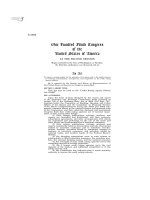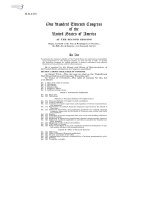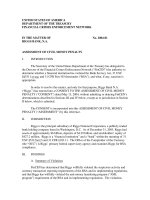UNITED STATES OF AMERICA DEPARTMENT OF THE TREASURY FINANCIAL CRIMES ENFORCEMENT NETWORK doc
Bạn đang xem bản rút gọn của tài liệu. Xem và tải ngay bản đầy đủ của tài liệu tại đây (69.25 KB, 10 trang )
UNITED STATES OF AMERICA
DEPARTMENT OF THE TREASURY
FINANCIAL CRIMES ENFORCEMENT NETWORK
IN THE MATTER OF No. 2004-01
RIGGS BANK, N.A.
ASSESSMENT OF CIVIL MONEY PENALTY
I. INTRODUCTION
The Secretary of the United States Department of the Treasury has delegated to
the Director of the Financial Crimes Enforcement Network (“FinCEN”) the authority to
determine whether a financial institution has violated the Bank Secrecy Act, 31 USC
§§5311
et seq. and 31 CFR Part 103 thereunder (“BSA”), and what, if any, sanction is
appropriate.
In order to resolve this matter, and only for that purpose, Riggs Bank N.A.
(“Riggs”) has entered into a CONSENT TO THE ASSESSMENT OF CIVIL MONEY
PENALTY (“CONSENT”) dated May 13, 2004, without admitting or denying FinCEN’s
determinations described in Sections III and IV below, except as to jurisdiction in Section
II below, which is admitted.
The CONSENT is incorporated into this ASSESSMENT OF CIVIL MONEY
PENALTY (“ASSESSMENT”) by this reference.
II. JURISDICTION
Riggs is the principal subsidiary of Riggs National Corporation, a publicly traded
bank holding company based in Washington, D.C. As of December 31, 2003, Riggs had
assets of approximately $6 billion, deposits of $4.29 billion, and stockholders’ equity of
$427.2 million. Riggs is a “financial institution” and a “bank” within the meaning of 31
USC §5312(a)(2) and 31 CFR §103.11. The Office of the Comptroller of the Currency
(the “OCC”) is Riggs’ primary federal supervisory agency and examines Riggs for BSA
compliance.
III. FINDINGS
A. Summary of Violations
FinCEN has determined that Riggs willfully violated the suspicious activity and
currency transaction reporting requirements of the BSA and its implementing regulations,
and that Riggs has willfully violated the anti-money laundering program (“AML
program”) requirement of the BSA and its implementing regulations. The violations
Riggs engaged in were systemic – Riggs was deficient in designing a program tailored to
the risks of its business that would ensure appropriate reporting, implementing the
procedures it did have, and responding to classic “red flags” of suspicious conduct.
Riggs failed to correct the violations and implement an adequate BSA program in a
timely manner. Consequently, on July 16, 2003, the OCC entered into a comprehensive
Consent Order with Riggs to correct the deficiencies and referred the BSA violations to
FinCEN for a determination of whether a civil penalty was warranted. Since then,
however, additional violations occurred and the OCC is concurrently issuing a
supplemental Consent Order requiring additional corrective actions.
B. Violations of the Anti-Money Laundering Program Requirements
FinCEN has determined that Riggs has been in violation of the AML program
requirements of the BSA. As of April 24, 2002, the BSA has required banks to establish
an AML program to guard against money laundering. A bank regulated by a Federal
functional regulator is deemed to have satisfied the requirements of 31 USC §5318(h)(1)
if it implements and maintains an AML program that complies with the regulation of its
Federal functional regulator governing such programs. 31 CFR §103.120. Since January
27, 1987, the OCC has required each bank under its supervision to establish and maintain
a BSA compliance program that, at a minimum: (a) provides for a system of internal
controls to ensure ongoing compliance; (b) provides for independent testing for
compliance conducted by bank personnel or an outside party; (c) designates an individual
or individuals responsible for coordinating and monitoring day-to-day compliance; and
(d) provides training for appropriate personnel. 12 CFR §21.21(c).
Riggs’ program contained serious deficiencies and was not in compliance with the
BSA regulations. In January 2003, Riggs’ program was deficient in all four elements
required by the AML program regulation. Some of the internal control and audit
deficiencies continued after the OCC’s Consent Order was issued. These deficiencies are
described in detail below.
1. Internal Controls
Riggs’ system of internal controls was inadequate to ensure ongoing compliance
with the BSA across all business lines. Riggs’ internal controls were not designed to take
into account the exposure posed by the customers, products, services, and accounts from
high-risk international geographic locations that are commonly viewed as high-risk for
money laundering. Indeed, Riggs’ internal controls proved insufficient to detect and
monitor risk, or to alert the bank to the need to take preventive or corrective action when
the risk materialized.
Riggs did not implement an effective system to identify and assess the BSA/AML
risk present throughout the institution. The risk matrices used in some of Riggs’
divisions all contained similar criteria, rather than being tailored to the particular lines of
business on a risk-graded basis, which weakened their effectiveness. As a result,
management was unable to define and analyze concentrations of risk in the accounts,
customers, locations, and products of Riggs.
2
Riggs’ customer due diligence program was weak and was not implemented in an
effective or consistent manner. Certain areas of Riggs failed to acquire or to use the
bank’s account opening and customer activity information collection procedures.
Further, customer due diligence information required by Riggs’ policies and procedures
was frequently missing. As a result, Riggs failed to identify a large number of accounts
associated with the governments of two foreign countries. Moreover, Riggs’ enhanced
due diligence policies and procedures governing high-risk areas were weak or, in some
cases, nonexistent. High-risk areas include high-risk transactions such as transactions
payable upon proper identification (“PUPID”), high-risk customers such as check cashers
and money remitters, and accounts involving high-risk international geographic locations
including international private banking, embassy banking, politically exposed persons,
and non-resident aliens. On two occasions, although Riggs’ management said that the
institution had discontinued PUPID transactions, Riggs allowed the transactions to
continue.
Riggs also failed to implement adequate internal controls to ensure the
identification of suspicious transactions and the timely filing of complete suspicious
activity reports (“SARs”) on reportable transactions. Riggs did not effectively use
procedures and automated technology already in place to identify and review suspicious
cash, monetary instruments, or wire activity. Riggs did not have procedures or internal
controls to ensure that subpoenas and other government requests regarding
accountholders were referred to the division responsible for investigating potential
suspicious activity.
Finally, internal controls were lacking in Riggs’ management of its largest
banking relationship, which involved the accounts of a foreign government, its politically
exposed persons, and the companies owned by such persons (described section III.C.3.
below). There was insufficient staff and procedures to monitor the accounts and a lack of
oversight over the account relationship manager and his staff. These problems continued
even after numerous warning signs indicated that Riggs needed to take corrective action.
2. Independent Testing
Riggs did not implement an adequate system for independent testing of BSA
compliance. The independent testing for compliance with the BSA was neither timely
nor effective for the level of risk within Riggs. The internal audit could not verify that
management’s corrective action for identified deficiencies were effective or timely. In
addition, the scope of the audit failed to include an evaluation of the areas of money
laundering vulnerabilities, BSA compliance, or the suspicious activity reporting process.
3
3. Designation of Individual(s) to Coordinate and Monitor
Compliance
Riggs also lacked effective monitoring for compliance by the BSA officer. Day-
to-day oversight and monitoring of high-risk transactions, high-risk customers, and high-
risk geographies were minimal. Strategies and alternative measures to ensure ongoing
BSA/AML monitoring for suspicious transactions were not adequately developed and
applied. In addition, the person(s) responsible for BSA compliance at Riggs failed to
adequately monitor, identify, investigate, analyze, and report suspicious activity.
4. Training Appropriate Personnel
Training on monitoring and detecting suspicious activity was particularly weak at
Riggs. For example, bank officer visits to customer business locations did not include
assessments of BSA/AML risk factors. In addition, branch personnel most familiar with
accounts held by money services businesses (“MSBs”) were unaware of the factors that
typically are associated with suspicious activity and the new BSA registration
requirements for MSBs.
In summary, Riggs failed to develop and maintain an effective BSA compliance
program in violation of 12 CFR § 21.21(c) and, thus, failed to establish and implement an
adequate AML program in violation of § 5318(h)(1) of the BSA and its implementing
regulation, 31 CFR § 103.120. Riggs’ faulty AML program resulted in its violation of
the suspicious activity and currency transactions reporting requirements of the BSA, as
discussed below.
C. Violations of the SAR Requirements
FinCEN has determined that from 2000 through 2003, Riggs violated the SAR
requirements of the BSA set forth in 31 USC §5318(g) and 31 CFR §103.18 by failing to
file or by delinquently filing approximately 33 SARs. These 33 SARs represent at least
$98 million in suspicious transactions.
1
1.
SAR Requirements
A bank must report any transaction involving or aggregating to at least $5,000
that it “knows, suspects, or has reason to suspect” (i) involves funds derived from illegal
activities or is conducted to disguise funds derived from illegal activities, (ii) is designed
to evade the reporting or recordkeeping requirements of the BSA (
e.g., structuring
transactions to avoid currency transaction reporting) or (iii) “has no business or apparent
lawful purpose or is not the sort in which the particular customer would normally be
expected to engage, and the bank knows of no reasonable explanation for the transaction
1
These SARs report transactions and categories of transactions described below. Generally, Riggs’ SAR
program suffered from a lack of timeliness. FinCEN’s review of SARs filed by Riggs from February 2000
through April 2004 disclosed an additional 61 SARs that were filed more than 60 days after the suspicious
activity occurred.
4
after examining the available facts, including the background and possible purpose of the
transaction.” 31 USC §5318(g) and 31 CFR §103.18.
The SAR regulation requires a bank to file SARs “to the extent and in the manner
required by this section” by “completing” a SAR Form. 31 CFR §103.18(a). A bank
must file a SAR no later than 30 calendar days after the date of initial detection of facts
that may constitute a basis for filing a SAR. 31 CFR §103.18(b)(3) and Instructions to
SAR Form, TD F 90-22.47. If no suspect is identified on the date of the detection of the
incident requiring the filing, a bank may delay filing a SAR for an additional 30 calendar
days to identify a suspect. In no case is reporting to be delayed more than 60 calendar
days after the date of initial detection of a reportable transaction. When filing a SAR, a
bank must provide a detailed description of why the transaction was unusual, irregular, or
suspicious in the narrative section of the form. Part V, SAR Form, TD F 90-22.47. The
form requires “a chronological and complete account” of the transaction. The form
emphasizes that the narrative description “is critical” and that the care with which it is
written “may determine whether or not the described conduct and its possible criminal
nature are clearly understood” by law enforcement.
To comply with the SAR rule, a bank must be able to determine whether
transactions are in fact reportable. Therefore, a bank is required to have in place systems
to identify the kinds of transactions and accounts that may be a high risk for money
laundering or that exhibit indicia of suspicious activity, considering the type of products
and services it offers and the nature of its customers. Otherwise, a bank cannot assure
that it is in fact reporting suspicious transactions as required by the BSA.
2
In this case,
the record shows that Riggs had information about its customers and their transactions
that caused it to “know, suspect, or have reason to suspect” that many transactions were
reportable suspicious transactions. However, Riggs failed to report these transactions,
delinquently reported them, and/or filed incomplete reports because Riggs’ procedures to
identify, analyze, and report suspicious activity were either non-existent or not
implemented. As a result, Riggs violated the SAR requirements of 31 USC §5318(g) and
31 CFR §103.18.
2.
Basic Deficiencies in SAR Procedures and Filings
As noted above, subpoenas and other matters were not appropriately referred for
investigation. As a result, Riggs failed to identify for review accounts in which
suspicious activity might be occurring. The SARs that were eventually filed by Riggs
reported activity that occurred two to three years before the date of filing.
Structuring, which is the breaking up of transactions for the purpose of evading
the BSA reporting and recordkeeping requirements, is often indicative of underlying
illegal activity. It is also unlawful under the BSA.
See 31 USC §5324. Structuring is
one of the most basic situations that an effective SAR program should be designed to
detect and report.
3
Riggs failed to discover that several customers had been structuring
2
See Matter of Korea Exchange Bank, No. 2003-04 (June 24, 2003).
3
See Matter of Western Union, No. 2003-2 (March 6, 2003).
5
transactions. These instances included the regular structuring of cash deposits into the
bank, as well as the structuring of money order purchases. Riggs belatedly filed SARs on
these transactions. However, most of these SARs were deficient because the narrative
descriptions of the transactions were sparse and conclusory. Rather than providing
specific information on the type, timing, and amount of activity observed in each
account, Riggs simply stated that there was an appearance of structuring. Riggs also
failed to report the total dollar amount allegedly structured in each account. Such
deficiencies make it difficult for law enforcement to evaluate whether the activity
described in the SAR is worth pursuing.
4
3. Embassy Banking/International Private Banking Relationships
Extensive and frequent suspicious cash, monetary instrument, and wire activity at
Riggs occurred within the accounts held by the government of a foreign country,
politically exposed persons of that country, and the companies owned by such persons,
where very little monitoring of activity was performed by the bank. Within this
relationship, there were a number of transactions that exhibited classic indicators of
suspicious activity, or at a minimum lacked any reasonable business or economic
purpose, but were never identified and reported. These transactions included:
− aggregate cash withdrawals from the accounts of the government, politically
exposed persons, and government employees that totaled tens of million of dollars
over a 2-year period, the majority of which were conducted through PUPID
transactions;
− dozens of sequentially numbered international drafts drawn from a politically
exposed person’s account on 3 dates over a 2-month period, totaling millions of
dollars, and made payable to the account holder, which were returned to Riggs for
crediting back to the account; and
− dozens of sequentially numbered cashier’s checks purchased from the same
above-listed account on 3 different dates over a period of six months, totaling tens
of millions of dollars, and made payable to the account holder, half of which were
returned to Riggs for deposit back into the account.
Riggs also failed to identify, monitor, and report suspicious activity related to the
accounts of another foreign government, its politically exposed persons, and the
companies owned by such persons. This was among Riggs’ largest depository
relationships; however, the relationship manager for these accounts had little or no
supervision. Riggs failed to monitor the activity in these accounts, despite various
indicators in early 2003 that should have alerted it to the high-risk nature of the
relationship, including publication of a newspaper article alleging official corruption and
Riggs’ receipt of a subpoena requiring documents regarding the relationship.
5
Meanwhile, Riggs failed to implement controls or monitor the ongoing activity.
4
See Matter of Great Eastern Bank of Florida, No. 2002-02 (Sept. 4, 2002).
5
Guidance on applying scrutiny to situations of this type has been available for some time. See Guidance
on Enhanced Scrutiny for Transactions that May Involve the Proceeds of Foreign Corruption (January
6
As a result of these deficiencies, Riggs could not properly identify, evaluate, and
report suspicious activity occurring in the relationship, including activity by its
employee, the relationship manager. Riggs failed to discover that the relationship
manager had signatory authority over two accounts within the relationship, received
funds from a government account within the relationship, and failed to file SARs on a
timely basis. Examples of the relationship manager’s suspicious transactions with
respect to this relationship include:
− alteration of a check from the account of a politically exposed person who is the
relative of a government official; and
− over $1 million in wire transfers from accounts owned by the government into the
account of a private investment corporation owned by the relationship manager at
another U.S. bank.
Riggs also failed to identify, evaluate, and report on suspicious activity occurring
in the accounts owned by the government involving transactions by and for the benefit of
politically exposed persons, including:
− cash deposits into the account of a private investment corporation owned by a
politically exposed person who is a government official, totaling millions of
dollars, over a 2-year period; and
− wire transfers, totaling hundreds of thousands of dollars, from a government
account to the personal account of another government official who had signature
authority over the government account.
D.
Violations of the CTR Requirements
FinCEN has determined that Riggs violated the BSA currency transaction
reporting requirements set forth at 31 CFR §103.27(d) by failing to provide accurate
information or omitting information on numerous currency transaction reports (“CTRs”).
Under the BSA, banks are required to file CTRs for transactions in currency greater than
$10,000 in a single day. 31 USC §5313 and 31 CFR §103.22. Banks are required to file
CTRs in the form prescribed by the Secretary of the Treasury and provide all the
information called for by the form. 31 CFR §103.27(d).
The CTRs filed by Riggs on two markets did not contain the accurate legal names
of those businesses. Over a one-year period, Riggs filed 90 CTRs representing $6
million for one market and 52 CTRs representing $1.3 million for the other market. The
businesses had been long-standing customers of Riggs before Riggs began filing CTRs
with their accurate legal names.
Riggs’ failure to collect, document, and verify customer and account information
resulted in its failure to provide accurate information on 6 CTRs filed on a company
2001), which was jointly issued by the Departments of the Treasury and State, the OCC, the Federal
Reserve, the Federal Deposit Insurance Corporation and the Office of Thrift Supervision.
7
owned by a politically exposed person who is a foreign government official. In the
CTRs, Riggs reported the company’s line of business as the export of timber, although
the entity was actually a private investment company holding the personal investments of
a politically exposed person who is a foreign government official. Together, the 6 CTRs
revealed $11.5 million in cash deposited over 2 years.
E. Willful Nature of BSA Violations
FinCEN has determined that Riggs’ violations of the BSA and its implementing
regulations were willful. The conduct of a bank may be characterized as willful if it
demonstrates a reckless disregard for its obligations under law or regulation. As an
OCC-supervised bank, Riggs was aware of the AML program, SAR, and CTR
requirements of the BSA and its implementing regulations. Riggs’ failure to establish
and implement a BSA/AML program adequate to meet its suspicious activity and
currency transaction reporting requirements constitute systemic violations demonstrating
a reckless disregard of its obligations under the BSA.
Riggs’ willfulness is further demonstrated by its failure to correct identified
deficiencies. The OCC deemed Riggs’ BSA compliance systemically deficient in 2003
and thus entered into a Consent Order with Riggs on July 16, 2003. However, Riggs is
not in full compliance with the OCC’s July 2003 Consent Order. Riggs’ failure to
establish and implement an adequate BSA compliance program, followed by its failure to
correct deficiencies identified by its primary Federal regulator, is a pattern of conduct
indicative of willfulness.
IV. CIVIL MONEY PENALTY
FinCEN has determined that by failing (1) to establish and implement an adequate
AML program, (2) to file timely, accurate, and complete SARs, and (3) to file accurate
and complete CTRs as described in Section III, above, Riggs willfully violated the AML
program, SAR, and CTR provisions of the BSA and a civil money penalty is due
pursuant to 31 USC §5321 and 31 CFR §103.57(f). In light of the seriousness of the
violations, their continuing and ongoing nature, the potential harm they pose to the
public, and taking into account the financial resources of Riggs, FinCEN has determined
that the appropriate penalty amount in this matter is $25 million.
V. CONSENT TO ASSESSMENT
In order to resolve this matter, and only for that purpose, Riggs, without
admitting or denying either the facts or determinations described in Sections III and IV
above, except as to jurisdiction in Section II, which is admitted, consents to the
assessment of a civil money penalty against it in the sum of $25 million. This penalty
assessment shall be concurrent with the $25 million penalty assessed against Riggs by the
OCC. The penalty assessment of FinCEN and the OCC referenced above shall be
satisfied by one payment of $25 million to the Department of the Treasury.
8
Riggs agrees to pay the amount of $25 million upon the assessment of the civil
money penalty. Such payment shall be:
a. made by certified check, bank cashier’s check, or bank money order or by
wire;
b. made payable to the United States Department of the Treasury;
c. any check or money order or copy of the wire transfer must be hand-
delivered or sent by overnight mail to Nicholas A. Procaccini, Assistant
Director and Chief Financial Officer, FinCEN, 2070 Chain Bridge Road,
Suite 200, Vienna, Virginia 22182; and
d. submitted under a cover letter, which references the caption and file
number in this matter.
Riggs recognizes and states that it entered into the CONSENT freely and
voluntarily and that no offers, promises, or inducements of any nature whatsoever were
made by FinCEN or any employee, agent, or representative of FinCEN to induce Riggs
to enter into the CONSENT, except for those specified in the CONSENT.
Riggs understands and agrees that the CONSENT embodies the entire agreement
between Riggs and FinCEN relating to this enforcement matter only, as described in
Section III above. Riggs further understands and agrees that there are no express or
implied promises, representations, or agreements between Riggs and FinCEN other than
those expressly set forth or referred to in the CONSENT and that nothing in the
CONSENT or this ASSESSMENT is binding on any other agency of government,
whether federal, state, or local.
9
VI. RELEASE
Riggs understands that its execution of the CONSENT and compliance with the
terms of this ASSESSMENT and the CONSENT constitute a complete settlement of civil
liability for reporting and recordkeeping violations of the BSA, and the regulations
promulgated thereunder, which were identified by the OCC prior to the date hereof.
By: ________________//s//________________
William J. Fox, Director
FINANCIAL CRIMES ENFORCEMENT NETWORK
U.S. Department of the Treasury
Date: _______May 13, 2004______________
10









